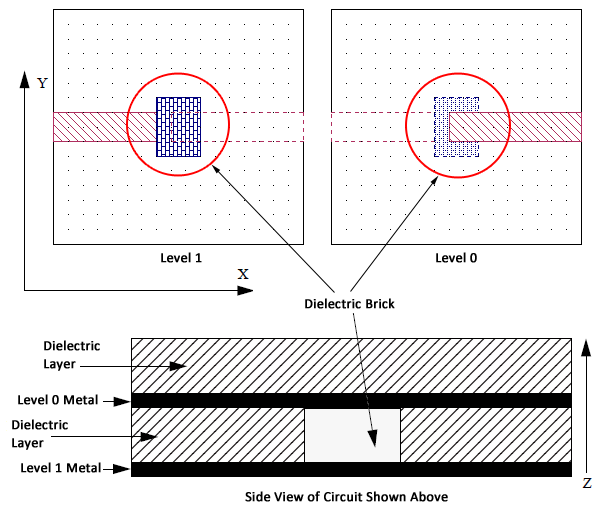Although em is primarily a planar electromagnetic simulator, it also has the capability to add “dielectric brick” material anywhere in your circuit. A dielectric brick is a solid volume of dielectric material embedded within a circuit layer. See the illustration below. Dielectric bricks can be made from any dielectric material (including air) and can be placed in circuit layers made from any other dielectric material (including air). For example, dielectric bricks can be used to simulate structures such as an embedded capacitor in an “air” circuit layer, or a small “air hole” in a dielectric substrate circuit layer. Dielectric bricks are best used for small volumes of dielectrics, such as MIM capacitors. While a large volume of dielectric can be implemented, it is extremely difficult to correctly model.
 Misuse of dielectric bricks can lead to significantly inaccurate results. It is highly recommended that you read this entire chapter before attempting to use dielectric bricks.
Misuse of dielectric bricks can lead to significantly inaccurate results. It is highly recommended that you read this entire chapter before attempting to use dielectric bricks.

All realizable values for the dielectric constant, loss tangent and bulk conductivity or resistivity can be used. Furthermore, it is possible to set these parameters independently in each dimension to create anisotropic dielectric bricks.
Em is appropriate for simple structures using very localized dielectric bricks; however, when your design requires large areas of brick material, you may need a full 3‑D electromagnetic analysis tool.
You should also be aware that the use of dielectric bricks can dramatically increase the memory requirements, and thus the simulation time, for your circuit. Bricks should only be used where strictly necessary for the accuracy of your simulation.
Care should be taken when using dielectric bricks, since improper modeling of your dielectric brick can yield highly inaccurate data. We recommend that you run a convergence test by doubling (or halving) the number of your Z-partitions, re-analyzing your circuit and comparing the two results to ensure that you are using a sufficient number of Z-partitions. For more information on Z-partitioning, see Z-Partitioning.
The use of dielectric bricks is appropriate for applications where the effects of dielectric discontinuities or anisotropic dielectric materials are important. Examples of such applications include dielectric resonators, dielectric overlays, airbridges, microstrip-to-stripline transitions, dielectric bridges and crossovers, microslab transmission lines, capacitors and module walls.